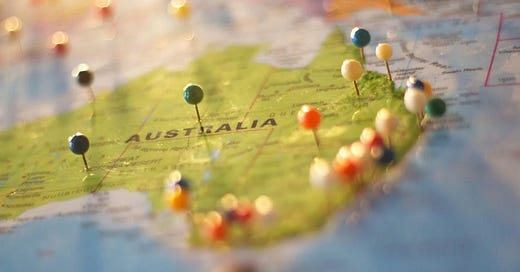Land Down Under Going Down Under
In my article Politicized Scientists, I provide a very brief history of the Commonwealth of Australia, a country that is over 90% of the landmass of the Australia/Oceania continent. The continent’s next largest nations are Papua New Guinea and New Zealand, and the remainder, 20 in total, are small island nations. Most of these island nations are members of the Alliance of Small Island States (AOSIS). It was this coalition that blindly set the insupportable, unscientific 1.5°C mark, which was indiscriminately adopted by the Paris Climate Accord and all its signatory countries.
The majority government of Australia is the Labor Party led by Prime Minister Anthony Albanese. The party has legislated a target of cutting emissions by 43% by 2030 from the nation’s 2005 levels and is committed to Net Zero emissions by 2050. The Labor Party has been in power since 2022 and won the May 2025 elections by a fair margin. The opposition, but with very limited power, consists mainly of the Liberal-National Coalition, which also holds net zero in esteem, but unlike the Labor Party, wants to do it through the use of nuclear power rather than the intermittency and unreliability of renewable energy.
As a result of the Labor Party’s resolute transition to renewable energies coupled with the closure of coal-fired power plants, there is a continuous escalation of electricity costs, causing considerable financial hardship on households and businesses, especially small and medium enterprises. Naturally, and politically, wind and solar are growing, but intermittency is causing a huge problem in both supply and pricing. Like every nation struggling with renewable energies, battery storage is dreadfully deficient and continues to be unaffordable and unworkable.
I illustrate the infeasibility of adequate battery storage in my articles Net Zero is a Complete Zero and A Saturday Short - Energy Storage - Mission Impossible. In a bizarre solution to this, the Aussie Government suggests that to rescue their climate change policies, homeowners and businesses buy their own batteries or use the ones in their electric vehicle to store electricity. The government claims that it cannot afford the necessary batteries. This is nonsensical and preposterous – to legislate a policy without the means or possibility to enact it.
Australia’s aging infrastructure, including transmission lines and substations, is endeavoring, without success, to keep up with the growing demand for electricity and the political transition to renewables. Adding to the energy expense, current transmission line costs are up as much as 55%.
Joanne Nova, an Australian science presenter, writer, speaker, and former TV host, details all of these down-under woes in an article entitled, “Bang! Price bomb sinks Transmission lines: Plan B says let’s pretend cars, home solar, and batteries will save “Transition””.
This failed experience in Australia will be realized by any country that thinks it can reduce carbon dioxide emissions through the use of renewable energies while prosecuting nuclear energy as evil. Renewable energies are medications for a condition that has no illness. Progressive politicians have been providers to this fictitious disease for so long that they simply cannot admit defeat.
Ironically, but also on a rather humorous note, likely the most famous band from Australia is the rock group AC/DC.




